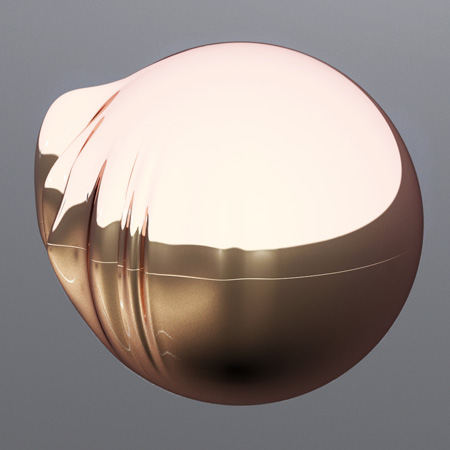French design collective Duende will display a collection of objects that explore the sharing of food between mother and child at La Cuisine in Nègrepelisse, France, this September.
Objects on show will include containers for burying the placenta, tableware for the ritual of eating the placenta and conceptual jewellery that could be made from the mother's breast milk.
Top image: 'Twilight' Urn for placenta in pink gold, Benjamin Graindorge / Duende collective (2008)
Above: Container for burying placenta, Gaëlle Gabillet / Duende collective (2008)
Above: Container for burying placenta, Benjamin Graindorge / Duende collective (2008)
Here's an explanation from Duende Collective:
--
"La part des Anges" Duende Collective from 13 septembre to 15 novembre 2008 at La Cuisine, creation & design applied to food
With Benjamin Graindorge, Eric jourdan, Gaëlle Gabillet, François Bauchet, Orh, Frédéric Ruyant, Cécile Fricker, Machin & Machin, Franck Magne, Oncle John, Grégoire Talon et Noë Noviant. Below: Container for burying placenta, Frédéric Ruyant / Duende collective (2008)
'La part des anges' - literally 'the angel's share' is a term used by French wine and spirit makers. It designates the percentage of evaporation necessary in the maturing of fine wines and spirits. This lost part was thought to be offered to the Angels, who even today are thought to watch over the vaporous activities of our culture. It reminds us of the sacrifice necessary in refining creations, whether they be drinks or human beings. Below: Container for burying placenta, Franck Magne / Duende collective (2008)
Mother and child. From conception to the post-natal period, the life-giving links in feeding between this primeval pair develop in two successive stages. First, the production of a shared temporary organ, the placenta, which is like a modem that connects the two bodies for feeding purposes during the 9 months of gestation. Second, the production of mother's milk, which extends the link after parturition in a relationship that is almost cannibal: the baby feeding on the mother, for the survival of both. Below:"Abalon", Container for burying placenta, Grégoire Talon / Duende collective (2008)
Commissioned by La Cuisine to reflect on the theme of 'eating together', Duende collective proposes a range of objects that re-evaluates the earliest human feeding habits which are intra uterine before becoming extra uterine. Proposals recall lost rituals that surround the placenta (burial, mummification, consumption), and attest its role as a protecting twin that guides and feeds the embryo and is sacrificed at birth. As for the breast-feeding stage, a new jewel has been created to figure its importance: the milk pearl. This 'gem' is made from the casein contained in milk produced by mammary glands. Below: Urn for placenta, Eric Jourdan / Duende collective (2008)
Duende collective is a group of French designers led by Anthony van den Bossche. Their shared interests are brought to focus on temporary projects: they are not exclusive and set no limits to their system of invitation. The editorial line of Duende collective is to bring to light cross-overs between the archaic, the organic and the ultra technological as they appear in the fabrication of new tools for contemporary people. Below: Urn for placenta, François Bauchet / Duende collective (2008)
1/ 'Angel dust' containers for placenta
Range of containers and pouches made of sunflower plastic for burial of placenta. Deep black in colour, this 100% biodegradable organic plastic forms a casket for the post partum placenta, which is buried under a tree to symbolize the life/death cycle and project an image of growth. This traditional rite was common in France up to the 17th century. Below: Urn for placenta & human ashes, Orh / Duende collective (2008)
2/ 'Angel dust memory' urn
These urns for placenta reduced to dust create a pre-natal funerary memorial in which the precious remains of the earliest form of human life are kept. In a way they materialize the idea of the 'guardian angel' who watches over a child, besides being a magic box charged with the secret vibrations of life and a keepsake of the time from conception to birth. The range revives ritual practices surrounding the placenta that go back to ancient Egypt, where they were thought to be the pharaoh's twin destined to accompany him all through life, and were housed in specially built temples. Below: Bowl for serving placenta, Orh / Duende collective (2008)
3/ Tableware for factitious cannibal feast
However bizarre, the ritual eating of human placenta is attested in certain societies. For us it implies imagining tableware accessories for a unique event. What forms can we imagine for a factitious cannibal feast? Below: Unleavened bread made from placenta, Noé Noviant / Duende collective (2008)
4/ 'Milk pearl' jewellery
Techniques for producing organic materials enable the fabrication of plastics made from human or animal milk by solidifying their casein content. The 'Perle de lait' range of jewellery imagines a new set of personalized post-natal objects. The breast-feeding mother sends a feeding bottle full of her milk to a laboratory where it is transformed into a gem-like substance that can be mounted on a neck-piece or any other form of jewellery. Below: Milk cameo, Cécile Fricker / Duende colective (2008)
13 septembre to 15 novembre 2008 at La Cuisine,
3, place du Monument aux Morts,
82800 Nègrepelisse (France)
In partnership with INRA Toulouse and 3D Prod rapid prototyping.
Above: Milk pearl, François Bauchet / Duende collective (2008)
Above: Necklace, Orh / Duende collective (2008)
Above: Domestic ornament, Benjamin Graindorge / Duende Collective (2008)

